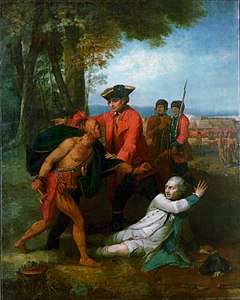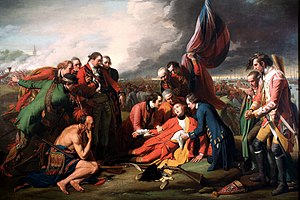 | |
| Year | 1764-1768 |
|---|---|
| Type | Oil on canvas |
| Location | Derby Museum and Art Gallery, Derby |
Warning: Display title "General Johnson Saving a Wounded French Officer from the Tomahawk of a North American Indian" overrides earlier display title "<i>General Johnson Saving a Wounded French Officer from the Tomahawk of a North American Indian</i>".
General Johnson Saving a Wounded French Officer from the Tomahawk of a North American Indian is a painting by Benjamin West, completed between 1764 and 1768. It depicts a scene as observed by a native of Pennsylvania, soon after the actual events shown. It is in the collection of Derby Museum and Art Gallery.[1][2]
Description[]
The painting is important as it is a contemporary view showing all three powers involved during the 1750s in the French and Indian War[1] (which could be called more comprehensively "the British, French and Indian War"[3]). It depicts Major General Sir William Johnson preventing a North American native warrior from taking the scalp of Baron Dieskau,[4] a wounded and defeated French soldier lying on the ground.[2]
West was an early American painter. He claimed to have been first taught how to make paint by a native American childhood friend who demonstrated how paint could be made by mixing clay with bear grease. This painting has fine detail on the native figure, whose plucked scalp and tattoos are shown in more detail than the Europeans' uniforms. West is known to have had a collection of North American artefacts which he used in his paintings.[5]
Benjamin West probably began this painting soon after his arrival in London, in 1763, when West returned from Italy, where he spent three years. Following The Indian Family, a painting of about 1761, this one demonstrates the same willingness to show "the proper dress and accoutrement".[6] Thus it provides us with one of two known contemporary pictures of the British Light Infantrymen for the French and Indian War period.[7] Whereas in the Italian painting, accuracy and authenticity were intended to give a generic representation of the Indian life, the new one employed them to make a report of a recent historical event.[4]
Although the subject matter and some "physical and symbolic details" could be found more closely corresponding to the Battle of Fort Niagara (1759),[8] the painting is usually related to an incident that occurred during the campaign of 1755 around Lake George, when the French commanded by Baron Dieskau, with their Indian allies, were opposed by a mixed troop of Mohawk and New England militia, led by Johnson. After having repulsed an attack against their camp, the British and their auxiliaries took over. Dieskau, wounded three times, had his life saved by Johnson, who protected him from the Mohawks wanting revenge for their killed kinsmen.[4] He actually survived and was taken as a prisoner to New York, then to London, and then to Bath for treatment of a still unhealed wound. At the end of the Seven Years' War in 1763, he was repatriated to France, where he died in 1767.[9]
West returned to the American war in his The Death of General Wolfe, exhibited in 1771, a much larger work that made his reputation, though causing controversy through its use of contemporary costume.
Historical context[]

West's The Death of General Wolfe, 1770
By showing Johnson restraining the aggressive actions of an auxiliary, the painting promotes "civilized" standards of honor and laws of war, as opposed to the ferocity of "savages". It refers to the concerns and debates that the employment of Indian allies aroused among Europeans, throughout the conflicts in North America.[4] Johnson's act of humanity contrasts against Johnson's reputation which has included him being described as a "White Savage" for his general attitude.[10]
At the beginning of the French and Indian War, young George Washington is said to have let Indian chief Tanaghrisson seal their fresh alliance by smashing the skull of Joseph Coulon de Jumonville, a wounded French officer they just took as prisoner, then washing his hands in the man's brain. The Jumonville affair caused a scandal in Europe, where it accelerated the expansion of the Seven Years' War.[3]
The same questions persisted during the War of Independence of the United States. In 1777, both Houses of British Parliament debated over the use of Indian auxiliaries. William Pitt's speech in the House of Lords (November 20), denouncing acts of violence perpetrated against "innocents" and the practice of cannibalism, is indicative of reluctances that appear to have been widely shared.[4]
Further reading[]
- Jonathon Conlin - Benjamin West's General Johnson and Representations of British Imperial Identity, 1759–1770. An Empire of Mercy?[11]
References[]
- ↑ 1.0 1.1 "Benjamin West Painting". The French & Indian War. warforempire.org. http://www.warforempire.org/relive/photo_gallery_Details.aspx?Gallery=7&image=54. Retrieved 2011-08-14.
- ↑ 2.0 2.1 ""General Johnson saving a Wounded French Officer from the Tomahawk of a North American Indian" by Benjamin West, PRA". Derby City Council. http://www.derby.gov.uk/LeisureCulture/MuseumsGalleries/ArttreasureGeneralJohnson.htm. Retrieved 2011-08-18.
- ↑ 3.0 3.1 Joel Achenbach (2006-12-16). "Clash of Empires: The British, French and Indian War, 1754-1763". p. C01. http://www.washingtonpost.com/gog/exhibits/clash-of-empires-the-british-french-and-indian-war-1754-1763,1093313/critic-review.html#reviewNum1. Retrieved 2011-08-14.
- ↑ 4.0 4.1 4.2 4.3 4.4 Stephanie Pratt, American Indians in British Art, 1700-1840, University of Oklahoma Press, 2005, 240 p. (ISBN 978-0806136578), p. 75-76.
- ↑ Pratt, Stephanie (2005). American Indians in British art, 1700-1840. Univ of Oklahoma Pr. pp. 85, 198. ISBN 978-0-8061-3657-8. http://books.google.co.uk/books?id=k2QEI_GiIsUC&pg=PA169&dq=benjamin+west+native+american+bear&hl=en&ei=BJQhTsrHB4-38QOYv5mtAw&sa=X&oi=book_result&ct=result&resnum=8&ved=0CFwQ6AEwBw#v=onepage&q=general%20johnson&f=false. Retrieved 2011-08-18.
- ↑ Pratt, Stephanie (2005). American Indians in British art, 1700-1840. Univ of Oklahoma Pr. pp. 75–76, 240. ISBN 978-0-8061-3657-8. http://books.google.com/books?id=k2QEI_GiIsUC&pg=PA76&dq=General+Johnson+saving+a+Wounded+French+Officer+from+the+Tomahawk+of+a+North+American+Indian&hl=fr&ei=ZhIbTsSIOYb1-gbyo-XXBw&sa=X&oi=book_result&ct=result&resnum=3&ved=0CDEQ6AEwAg#v=onepage&q=General%20Johnson%20saving%20a%20Wounded%20French%20Officer%20from%20the%20Tomahawk%20of%20a%20North%20American%20Indian&f=false. Retrieved 2011-08-18.
- ↑ "Uniforms of the 46th Regiment of Foot" (in 英語) (PDF). Schroth's New York Company. p. 2. http://schrothscompany.com/document_folder/46th_Uniforms.pdf. Retrieved 2011-08-18.
- ↑ Pierre Pouchot, Michael Cardy (translation) and Brian Leigh Dunnigan (edition and notes), Memoirs on the Late War in North America Between France & England ((French) Mémoires sur la dernière guerre de l'Amérique septentrionale entre la France et l'Angleterre, Switzerland, Yverdon, 1781), Youngstown (N.Y.), Old Fort Niagara Association, 1994, 568 p. (ISBN 9780941967143), p. 232 (note).
- ↑ James R. Turnbull (2000). "Dieskau, Jean-Armand, baron de Dieskau". Dictionary of Canadian Biography Online. University of Toronto/Université Laval. http://www.biographi.ca/009004-119.01-e.php?&id_nbr=1319&interval=20&&PHPSESSID=m36eohutgdsj1hnnadash68ii1. Retrieved 2011-08-18.
- ↑ O'Toole, Fintan. White Savage: William Johnson and the Invention of America. New York: Farrar, Straus and Giroux, 2005. ISBN 0-374-28128-9
- ↑ Conlin, Jonathon (2004). "Benjamin West's General Johnson and Representations of British Imperial Identity, 1759–1770. An Empire of Mercy?". pp. 37–59. Digital object identifier:10.1111/j.1754-0208.2004.tb00277.x. http://onlinelibrary.wiley.com/doi/10.1111/j.1754-0208.2004.tb00277.x/abstract. Retrieved 4 February 2012.
The original article can be found at General Johnson Saving a Wounded French Officer from the Tomahawk of a North American Indian and the edit history here.